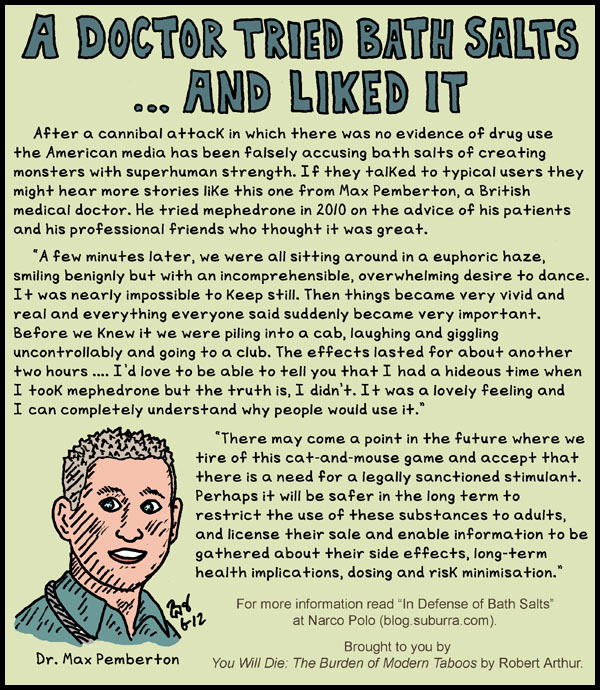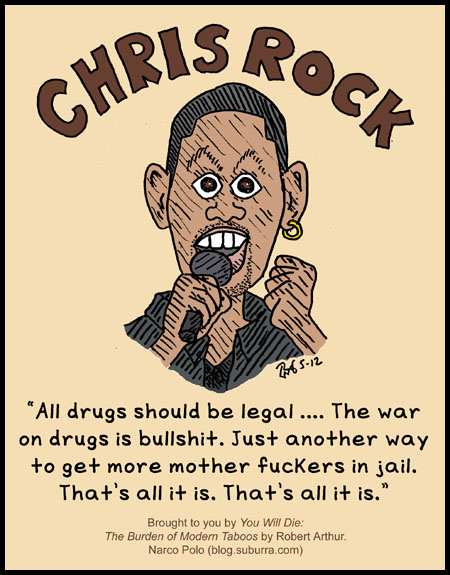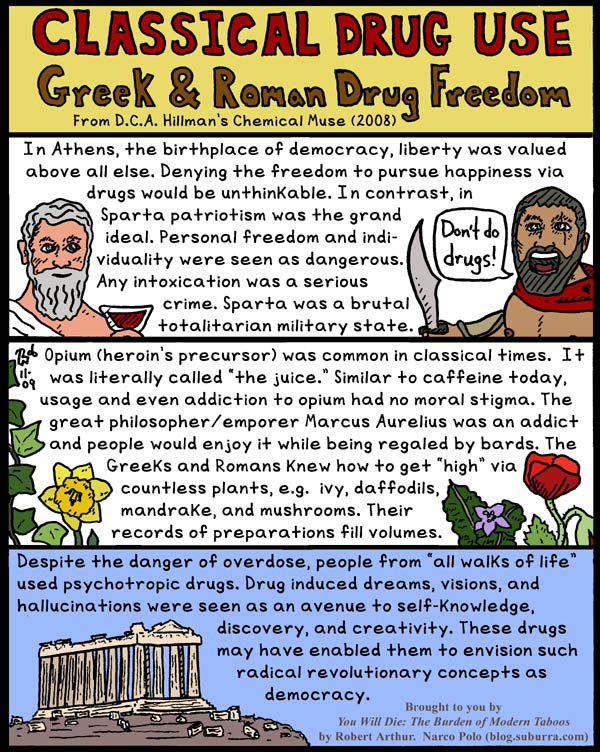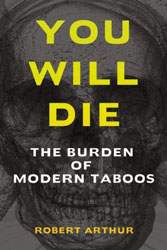Doctor Tried Bath Salts and Liked It: In Defense of Bath Salts
Posted: June 8th, 2012 | Filed under: bath salts, drugs, legalization, media bias | 11 Comments »
On May 26, 2012, a naked Rudy Eugene ate the face of Ronald Poppo by a Miami causeway. That evening CBS Miami featured the following interchange between news anchor Cynthia Demos and reporter Tiffani Helberg:
Cynthia Demos: The officer believes the man clearly, clearly was on some very, very powerful drugs.
Tiffani Helberg: That’s right, Cynthia. The Fraternal Order of Police president [Armando Aguilar] tells me this crop of LSD [bath salts] is a major threat to police officers as well as the rest of us. He says it turns normal people into monsters that possess this superhuman strength and no ability to feel pain. He believes that’s what was behind the incident that unfolded here …. (5)
The Truth
Everything Helberg said was false and there was no evidence Eugene was on drugs. However, based largely on Aguilar’s specious speculation the media released an avalanche of drug bashing on bath salts. Bath salts usually refer to synthetic versions of cathinone, the psychoactive chemical in the khat bush. Khat leaves have been consumed by Africans for over 700 years without being associated with bizarre behavior. They use it in the same cultural manner that Westerners use caffeine.
Cathinones are merely stimulants. When researchers go beyond colorful anecdotes and urban myths the evidence is scant that stimulants cause violence and they certainly do not cause superhuman strength or an inability to feel pain. (6) Extreme use of any stimulant – even caffeine – can cause temporary psychosis, and can trigger schizophrenia in those that are predisposed to it. (These effects are not limited to drugs. Extreme sleep deprivation can also cause temporary psychosis, and any highly stressful event can trigger schizophrenia in those that are predisposed.)
Psychosis and drug use are not statistically significant predictors of violence by themselves. It is only when both are combined with violent tendencies that it is problematic. (3,7) Violent people and those with severe mental health issues should avoid overusing stimulants, just like they should avoid overusing the drug whose correlation with violence dwarfs all others – alcohol. (2) (Read about “Legal Drug Linked to More Cannibalism than Bath Salts.”)
The Doctor Who Had Fun
Extreme behavior from using bath salts is rare and yet the media insists on presenting only the horror stories. They take sensational quotes from doctors and police whose sole exposure to cathinone users is from emergency rooms and crime scenes. If doctors and police only had exposure to drinkers in emergency rooms and crime scenes their view of alcohol would be just as distorted.* (For another reason for distortion see “The Banana Effect: How Drugs Get a Bad Rap from Their Users.”)
If the media bothered to quote typical cathinone users, the public would hear more stories like that of the British medical doctor, Max Pemberton. Pemberton had heard his patients rave about the drug mephedrone that they enjoyed taking on the weekends. (Mephedrone is one of the cathinones commonly sold as bath salts. It was sold in Britain not as a bath salt, but as a plant food, and acquired the street name meow-meow.) When he asked his friends about mephedrone – a lawyer, an architect, and two people in publishing – they all told him “how good it was.” Pemberton tried it with another doctor and some friends on a Saturday in March of 2010. This is how he described the experience:
A few minutes later, we were all sitting around in a euphoric haze, smiling benignly but with an incomprehensible, overwhelming desire to dance. It was nearly impossible to keep still. Then things became very vivid and real and everything everyone said suddenly became very important. Before we knew it we were piling into a cab, laughing and giggling uncontrollably and going to a club. The effects lasted for about another two hours …. I’d love to be able to tell you that I had a hideous time when I took mephedrone but the truth is, I didn’t. It was a lovely feeling and I can completely understand why people would use it. (8)
Ignorant Newspaper Editors
The British media sensationalized mephedrone in 2009 just as the American media is now. Yellow journalism resulted in stories about mephedrone deaths including Gabrielle Price, a 14-year-old girl. She was made the poster child of mephedrone evil even though a later investigation found that she died of pneumonia – not mephedrone. Of the 27 fatalities attributed to mephedrone by the screaming press, coroners eventually determined that only two could have been caused by mephedrone. (To read how drug deaths are often fabricated read, “Billy Mays’ Corpse Gets Trampled by Cocaine Hype.”) A headline grabber about a boy on mephedrone who ripped his scrotum off was also later debunked. (4)
Mephedrone was banned in the UK in April 2010. A member of the UK’s independent expert body that advises the government on drug-related issues quit because of pressure by media and politicians to make a quick decision on banning mephedrone without examining the evidence. (1) The New Scientist wrote of the ban:
If governments continue to tailor their drugs policies to pacify loud but ignorant newspaper editors, their policies will soon cease to be relevant in the real world. If they want their drugs policy to work, it must be thoughtful, rational and evidence-based, not a cynical, politically motivated stunt to pacify the editors of tabloid newspapers. (9)
(For an alternate theory of the Causeway Cannibal read “Did Bible Study and Anti-Drug Vow Cause Miami Cannibal Attack?”)
* This phenomenon is called the clinician’s error and is explained in more detail at Maia Szalavitz’s article at Time.com, “Why Drugs Are Getting a Bum Rap in the Miami Face-Eating Attack.”
Addendum (June 28, 2012) – The full toxicology report of Rudy Eugene released on June 27, 2012 reported that the only drug found in his body was marijuana. The common chemicals in drugs sold as bath salts were absent. LINK
Sources
1. “A Collapse in Integrity of Scientific Advice in the UK,” Lancet, 17 Apr. 2010. LINK
2. Martin Brecher, et al., “Phencyclidine and Violence,” J. Clin. Psychopharmacol., Dec. 1988.
3. Eric Elbogen & Sally Johnson, “Intricate Link Between Violence and Mental Disorder,” Arch. Gen. Psychiatry, Feb. 2009.
4. Nic Fleming, “Truth About Mephedrone,” New Scientist, 24 Apr. 2010.
5. Tiffani Helberg, “Miami Police Shoot, Kill Man Eating Another Man’s Face,” CBSLocal.com, 26 May 2012. LINK
6. Peter Hoaken & Sherry Stewart, “Drugs of Abuse and the Elicitation of Human Aggressive Behavior,” Addict. Behav., 2003, 28.
7. Rick Nauert, “Mental Illness Does Not Predict Violence,” PsychCentral.com, 26 Feb. 2009.
8. Max Pemberton, “I Took Mephedrone and I Liked It,” Telegraph.co.uk, 20 Mar. 2010. LINK
9. “Politics of Facebook,” New Scientist, 24 Apr. 2010.




